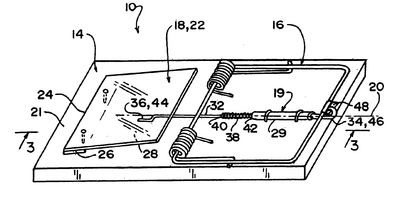
A Few Tips For Reviewing A Patent Application
© 2010, Dawsey Co., LPA
February 2010
For many inventors, and especially first-time inventors, making a thorough review of a patent application can seem like a daunting task. After all, the typical patent application is often dozens of pages in length and written in a style that is rarely encountered in everyday texts. While intimidating, the inventor’s review is an important aspect of the patent application preparation process because although the attorney will know more about the patent laws, the inventor will know the ins and outs of the invention better than anyone.
Generally, the patent application may be broken down into several parts: the specification, the claims, and the drawings. To aid in the review of your patent application, consider the following when reviewing each application part.
The Drawings
Because they are usually the easiest part of the patent application for an inventor to review, it is wise to start with the drawings. We generally include an “Element List” with each application that associates a reference numeral with each element of the invention. A careful review of the drawings along with the element list will help familiarize the inventor with the name of each structure discussed in the application, along with relationships among the parts.
A typical patent application will include several pages of drawings to illustrate the invention and its elements. In making your review, you will want to familiarize yourself with the element list and check whether the elements are appropriately labeled throughout the figures. Is anything wrongly labeled or drawn incorrectly? If so, these errors will likely be reflected in the other parts or the application. Remember though, that multiple embodiments will generally require multiple drawings, so that it is not necessary that all embodiments be shown in a single drawing, or even group of drawings; so long as all embodiments are represented. It is possible that some variants and embodiments will only be described in the application, and not illustrated, but make note of any that are not shown, to make sure that they are included elsewhere in the application.
The Claims
The claims are the most important part of the patent application because they define the legal “metes and bounds” of the invention. Should a patent issue on the invention, it will be the claims that determine whether a competing product or process is infringing. Given the importance of the claims, you should keep the following questions in mind as you begin your review.
One question you should consider is whether the claims actually cover what you think you have invented. In other words, if you think you have invented a new type of golf ball, does the claim begin “An improved golf club head?” This seems pretty basic, but should be considered nonetheless.
Another thing to consider is whether every element included in the claim is really necessary. When it comes to patent claims, less is more. Including elements in the independent claims that are not required for the invention to operate and maintain its novelty will result in claims that are unnecessarily narrow and easier for competitors to design around to avoid infringement. If the element is important, but not essential, then it may be best to include the element in a dependent claim.
Along similar lines, consider whether there are words in the claim that are unduly limiting. For example, if a claim recites a nail for connecting part A to part B, then the claim will literally cover only those devices where a nail is used to connect part A to part B. The better approach is to simply say that part A is connected to part B. Also, closely review any adjectives that are used in the claims. It is possible that an adjective may needlessly limit the element; for example, the claim recites a “rectangular rod” when a “rod” of any shape would work. Further, consider whether the wording used to describe an element of the invention covers alternative embodiments of which you are aware. The takeaway here is to consider whether a more generic word may be used, or whether a word is even necessary at all.
Often times the claims may describe a specific arrangement of the elements or steps. You should consider whether the elements must actually be arranged as described in the claim. For instance, if the claim says that “part A is connected to the back surface of part B,” would the invention work if “part A” were connected to the “front surface of part B,” or just “a surface of part B”?
The Specification
The remainder of the written portion of the patent application is known as the specification. The purpose of the specification is to provide a written description of the invention to enable a person skilled in the art to make and use the invention. A typical specification will include the following sections: Background of the Invention; Summary of the Invention; Brief Description of the Drawings; and Detailed Description of the Invention. Of these sections, the “Detailed Description” is the most important, and thus you should review this section closely. When reviewing the specification, you should focus on the content as opposed to grammar and style
In general, the text of the “Detailed Description” should step the reader through the figures in discussing the elements of the invention. Moreover, the text should describe how the elements relate to one another and should cover the scope of the claims. With respect to the claims, it is important for the “Detailed Description” to present a thorough description of the elements. Please keep in mind that the exact terminology used in the claims should also be used in the “Detailed Description.” Furthermore, consider variations or alternatives to each element to support a range of embodiments of the invention. This may widen the scope of protection as well as provide options to work with during prosecution.
The specification must also disclose the “best mode” contemplated by the inventor for carrying out the invention at the time the application is filed. Thus, you need to make sure that the “Detailed Description” completely describes the preferred embodiments for practicing the invention. Please note that the “best mode” need not be specifically identified in the specification.
Conclusion
With these ideas in mind, you are now ready to review the patent application. As mentioned above, the inventor’s review is an important step in preparing the patent application for filing. Be sure to provide any comments or suggestions that you may have so that they may be incorporated into the application. After all, once the application is filed, no “new matter” may be added to this particular application.
